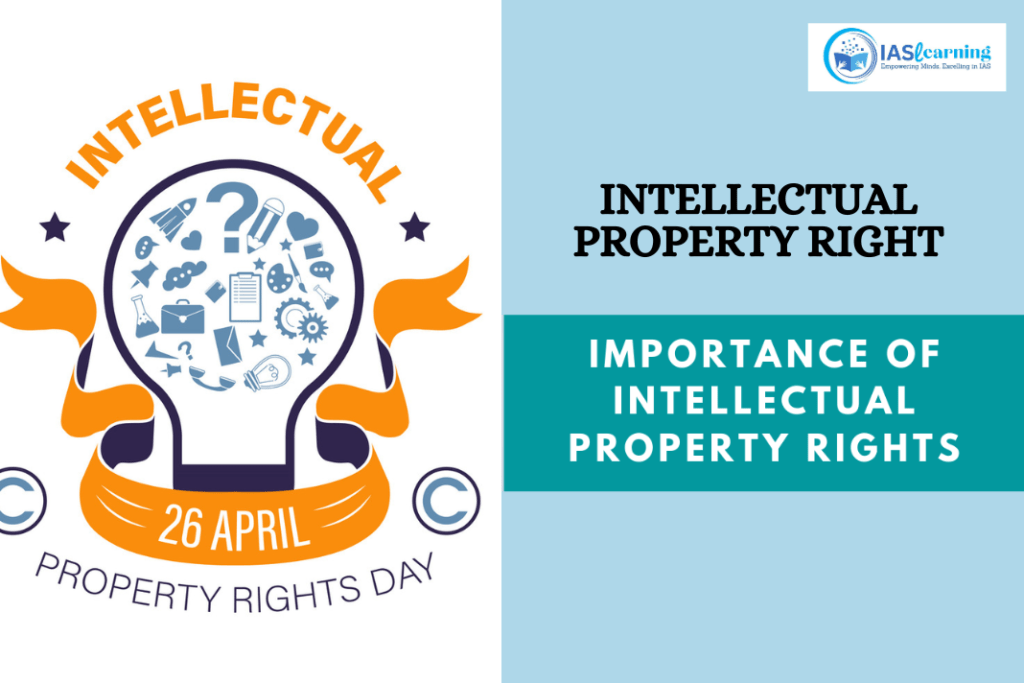INTRODUCTION TO INTELLECTUAL PROPERTY RIGHTS
Intellectual property rights (IPR) are the rights given to persons over the creations of their minds, i.e., inventions, literary and artistic works, and symbols, names and images used in commerce. They usually give the creator an exclusive right over the use of his/her creation for a certain period of time.
Laws & Rules that govern Intellectual Property Rights (IPR)
- The importance of IPR was first recognized in the
- Paris Convention for the Protection of Industrial Property (1883) &
- Berne Convention for the Protection of Literary & Artistic Works (1886).
- Both are administered by the World Intellectual Property Organization (WIPO).
- IPRs have been outlined in Article 27 of the Universal Declaration of Human Rights, which provides for the right to benefit from the protection of moral and material interests resulting from authorship of scientific, literary or artistic productions.
- WTO governs IPR through Trade-Related Aspects of the Intellectual Property Rights (TRIPS).
India and Intellectual Property Rights
- Acts Dealing with Intellectual Property Rights in India are:
- The Copyright Act, 1957
- The Patents Act, 1970
- The Trademarks Act, 1999
- The Geographical Indications of Goods (Registration and Protection) Act, 1999
- India adopted the National Intellectual Property Rights (IPR) Policy as a vision document to guide the future development of IPRs in the country.
- The Department of Industrial Policy & Promotion (DIPP) under the Ministry of Commerce has been appointed as the nodal department to coordinate, guide, and oversee the implementation and future development of IPRs in India.
- The Cell for IPR Promotion & Management (CIPAM), set up under DIPP, is to be the single point of reference for the implementation of the objectives of the National IPR Policy.
- The campaign ‘KAPILA’, which stands for Kalam Program for Intellectual Property Literacy and Awareness campaign, was launched on 15th October 2020. The day was launched in honor of the 89th birth anniversary of former President Dr. APJ Abdul Kalam.
- India is a member of the World trade organization’s Trade-Related Aspects of Intellectual Property (TRIPS) Agreement.
- India is also a signatory to the following international IP agreements:

- Paris Convention: Under this, any person from a signatory state can apply for a patent or trademark in any other signatory state and will be given the same enforcement rights and status as a national of that country would be.
- Berne Convention: Under this, each member state recognizes the copyright of authors from other member states in the same way as the copyright of its own nationals.
- Madrid Protocol: Under this, a person can file a single trademark application at their national office that will provide protection in multiple countries;
- Patent Cooperation Treaty: This is a central system for obtaining a ‘bundle’ of national patent applications in different jurisdictions through a single application.
- Hague Agreement: India is not a signatory to the Hague Agreement, which allows the protection of designs in multiple countries through a single filing.
Types of IPR
Intellectual property rights are customarily divided into two main areas:
- Copyright and rights related to copyright: The rights of authors of literary and artistic works (such as books and other writings, musical compositions, paintings, sculpture, computer programs and films) are protected by copyright, for a minimum period of 50 years after the death of the author.
- Industrial property: Industrial property can be divided into two main areas i.e., Protection of distinctive signs, in particular trademarks and geographical indications.
- Trademarks distinguish the goods or services of one undertaking from those of other undertakings.
- Geographical Indications (GIs) identify a good as originating in a place where a given characteristic of the good is essentially attributable to its geographical origin.
- The protection of such distinctive signs aims to stimulate and ensure fair competition and to protect consumers, by enabling them to make informed choices between various goods and services.
- The protection may last indefinitely, provided the sign in question continues to be distinctive.
- Industrial designs and trade secrets: Other types of industrial property are protected primarily to stimulate innovation, design and the creation of technology. In this category fall inventions (protected by patents), industrial designs and trade secrets.
- IP can be either registered or unregistered
- ™ refers to the unregistered trademark to promote or brand goods. Unregistered forms of IP include copyright, unregistered design rights, common law trademarks and database rights, confidential information and trade secrets.
- R – within a circle refers to the registered trademark. It is used by the owner of a trademark that has been registered. Registered forms of IP include patents, registered trademarks and registered design rights. Copyright is also registerable.
| World Intellectual Property Day |
| World Intellectual Property Day is celebrated on April 26 every year to promote discussion of the role of IP in encouraging innovation and creativity. |

National IPR Policy
- The National Intellectual Property Rights (IPR) Policy 2016 was adopted in May 2016 as a vision document to guide future development of IPRs in the country.
- Its clarion call is “Creative India; Innovative India”.
- It encompasses and brings to a single platform all IPRs, taking into account all inter-linkages and thus aims to create and exploit synergies between all forms of intellectual property (IP), concerned statutes and agencies.
- It sets in place an institutional mechanism for implementation, monitoring and review. It aims to incorporate and adapt global best practices to the Indian scenario.
- Department of Industrial Policy & Promotion (DIPP), Ministry of Commerce, Government of India, has been appointed as the nodal department to coordinate, guide and oversee the implementation and future development of IPRs in India.
- The Cell for IPR Promotion & Management (CIPAM), set up under the aegis of DIPP, is to be the single point of reference for implementation of the objectives of the National IPR Policy.
- India’s IPR regime is in compliance with the WTO’s agreement on Trade-Related Aspects of Intellectual Property Rights (TRIPS).
Objectives of National IPR Policy
- IPR Awareness: To create public awareness about the economic, social and cultural benefits of IPRs among all sections of society.
- Generation of IPRs: To stimulate the generation of IPRs.
- Legal and Legislative Framework: To have strong and effective IPR laws, which balance the interests of rights owners with larger public interest.
- Administration and Management: To modernize and strengthen service- oriented IPR administration.
- Commercialization of IPRs: Get value for IPRs through commercialization.
- Enforcement and Adjudication: To strengthen the enforcement and adjudicatory mechanisms for combating IPR infringements.
- Human Capital Development: To strengthen and expand human resources, institutions and capacities for teaching, training, research and skill building in IPRs.
Achievements under new IPR policy
- Improvement in GII Ranking: India’s rank in the Global Innovation Index (GII) issued by WIPO has improved from 81st in 2015 to 40th place in 2022.
- Strengthening of institutional mechanism regarding IP protection and promotion.
- Clearing Backlog/ Reducing Pendency in IP applications: Augmentation of technical manpower by the government, has resulted in drastic reduction in pendency in IP applications.
- Automatic issuance of electronically generated patent and trademark certificates has also been introduced.
- Increase in Patent and trademark Filings.
- IP Process Re-engineering Patent Rules, 2003 have been amended to streamline processes and make them more user friendly. Revamped Trademarks Rules have been notified in 2017.
- Creating IPR Awareness: IPR Awareness programs have been conducted in academic institutions, including rural schools through satellite communication, and for industry, police, customs and judiciary.
- Technology and Innovation Support Centers (TISCs): In conjunction with WIPO, TISCs have been established in various institutions across different states.

Patents Act, 1970
- This principal law for patenting system in India came into force in the year 1972. It replaced the Indian Patents and Designs Act 1911.
- The Act was amended by the Patents (Amendment) Act, 2005, wherein product patent was extended to all fields of technology including food, drugs, chemicals and microorganisms.
- After the amendment, the provisions relating to Exclusive Marketing Rights (EMRs) have been repealed, and a provision for enabling grant of compulsory license has been introduced.
- The provisions relating to pre-grant and post-grant opposition have also been introduced.
Patents (Amendment) Rules, 2021
- Patent Fees for Educational Institutions Reduced
- Educational institutions engage in many research activities, where professors and teachers and students generate several new technologies which need to be patented for facilitating commercialization of the same.
- At the time of applying for patents, the innovators have to apply these patents in the name of the institutions which have to pay fees for large applicants, which are very high and thus work as a disincentive.
- In this regard and to encourage greater participation of the educational institutions, official fees payable by them in respect of various acts under the Patents Rules, 2003, have been reduced by way of the Patents (Amendment) Rules, 2021.
- Benefits related to 80% reduced fee for patent filing & prosecution have been extended to all educational institutions. This benefit was earlier available to all recognized educational institutions owned by the government.
- Extension of Expedited Examination System
- The fastest granted patent is the one which was granted in 41 days after filing such a request. This facility of Expedited Examination system was initially provided for patent applications filed by Startups.
- It has been now extended to 8 more categories of Patent Applicants:
SME (Small and Medium Enterprises), Female applicants, Government Departments, Institutions established by a Central, Provincial or State Act, Government Company, an Institution wholly or substantially financed by the Government and applicants under Patents Prosecution Highway. - The Patent Prosecution Highway (PPH) is a set of initiatives for providing accelerated patent prosecution procedures by sharing information between some patent offices.
Criteria for issuing Patents in India
- Novelty: It should be new, not previously published, and not previously known to or used by the Indian public.
- Non obviousness: It must involve a creative step, be technically superior to prior information, and be novel to someone with relevant technical understanding.
- Industrial use: It should be capable of Industrial application.
- Patents in India are governed by “The patent Act 1970” which was amended in 2005 to make it compliant with TRIPS.
Term of Patent
The term of every patent in India is twenty years from the date of filing the patent application, irrespective of whether it is filed with provisional or complete specification.
Issues in India’s IPR regime
- Evergreening of Patents: Section 3(d) of the Indian Patent Act 1970 (as amended in 2005) does not allow patent to be granted to inventions involving new forms of a known substance unless it differs significantly in properties with regard to efficacy.
- This means that the Indian Patent Act does not allow evergreening of patents.
- This has been a cause of concern to the pharma companies. Section 3(d) was instrumental in the Indian Patent Office (IPO) rejecting the patent for Novartis’ drug Glivec (imatinib mesylate).
- Compulsory licensing (CL): CL is problematic for foreign investors who bring technology as they are concerned about the misuse of CL to replicate their products. It has been impacting India-EU FTA negotiations.
- CL is the grant of permission by the government to entities to use, manufacture, import or sell a patented invention without the patent-owner’s consent. Patents Act in India deals with CL.
- CL is permitted under the WTO’s TRIPS (IPR) Agreement provided conditions such as ‘national emergencies, other circumstances of extreme urgency and anti-competitive practices’ are fulfilled.
- India continues to remain on the United States Trade Representative’s (USTR’s) ‘Priority Watch List’ for alleged violations of intellectual property rights (IPR).
- In its latest Special 301 report released by the United States Trade Representative (USTR), the US termed India as “one of the world’s most challenging major economies” with respect to protection and enforcement of IP.
- Data Exclusivity: Foreign investors and MNCs allege that Indian law does not protect against unfair commercial use of test data or other data submitted to the government during the application for market approval of pharmaceutical or agro-chemical products. For this they demand a Data Exclusivity law.
- Enforcement of the Copyright act is weak, and piracy of copyrighted materials is widespread.
Advantages of IPR
- Safeguards creators’ rights
- Promotes innovation and creativity
- Facilitates ease of doing business
- Enhances economic value
- Expands the export regime
Disadvantages of IPR
- Expensive for first IPR filing for nay process of the product.
- Pirating has still not stopped after IPR protection.
- Quality is compromised with the aging of IPR.
- IPR was considered a hindrance during the COVID-19 vaccine distribution system initially as IPR restrictions made low and middle-income countries unable to manufacture vaccines domestically.
Way Forward
- Promoting an environment of innovations in schools. The academic curricula need to be rebooted.
- A proper resolution mechanism for resolving IPR related issues is needed.
- India will be unable to take full advantage of the transformative benefits of a strong IP system unless and until it addresses gaps in its IP laws and regulations.
- Success of India’s flagship programmes – Make in India and Start up India – depends on the boost of innovation ecosystem with better IPR safeguarding.
- More awareness is needed about the creation, protection and enforcement of IPRs to encourage the Indian industry not only to innovate but also to protect and enforce their innovations.
- READ MOREhttps://www.ncbi.nlm.nih.gov/
- VISIT UShttps://iaslearning.in/




